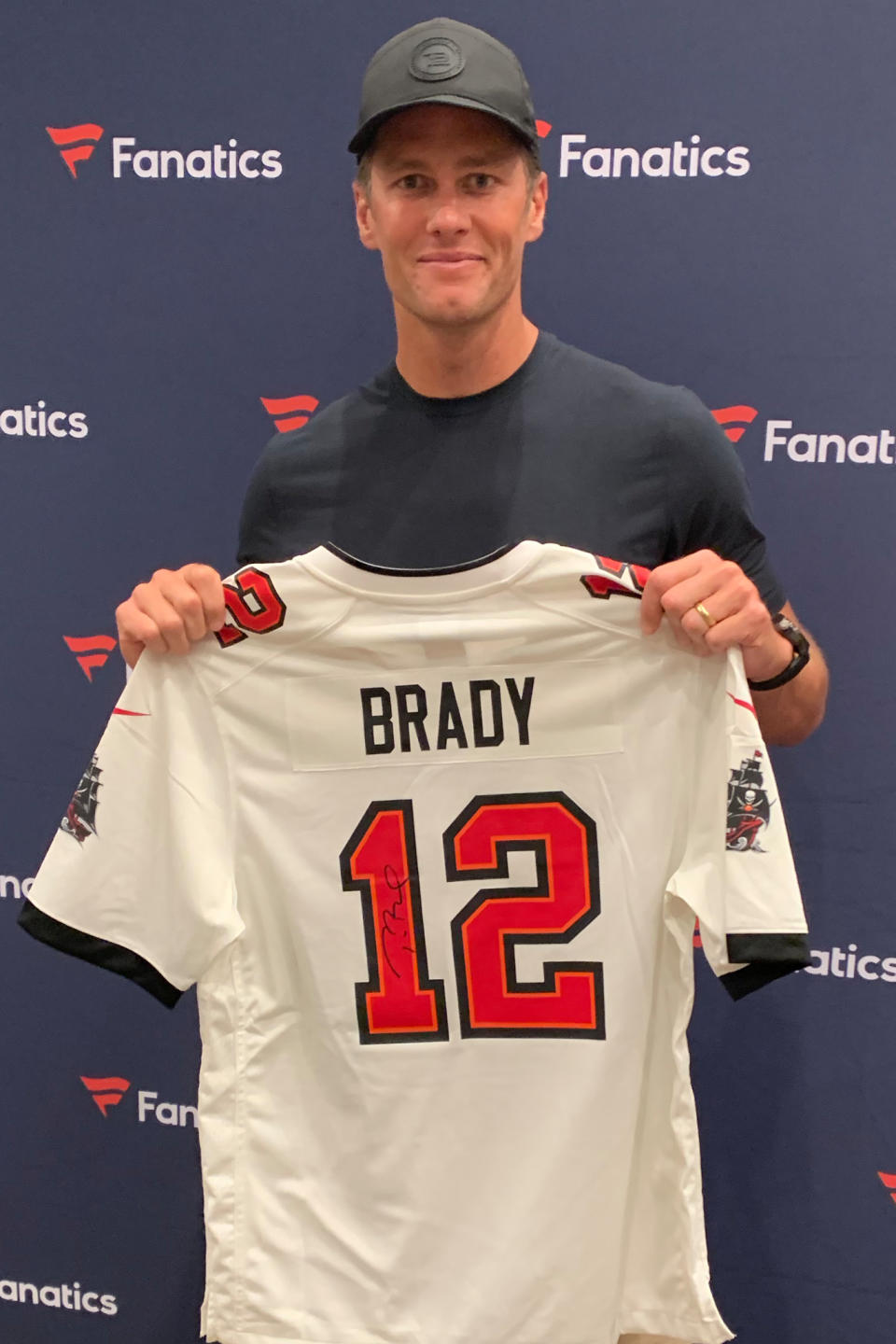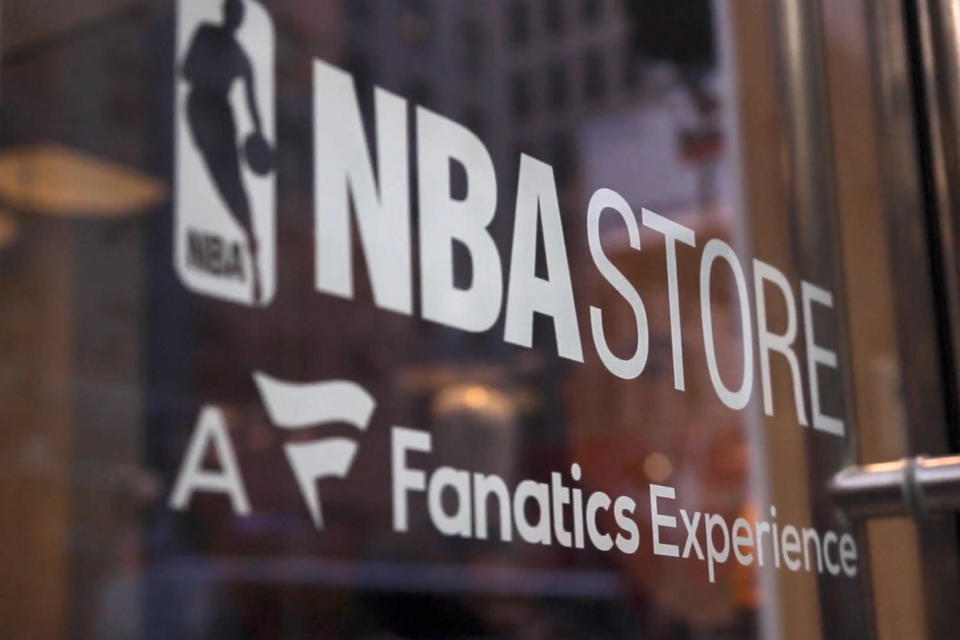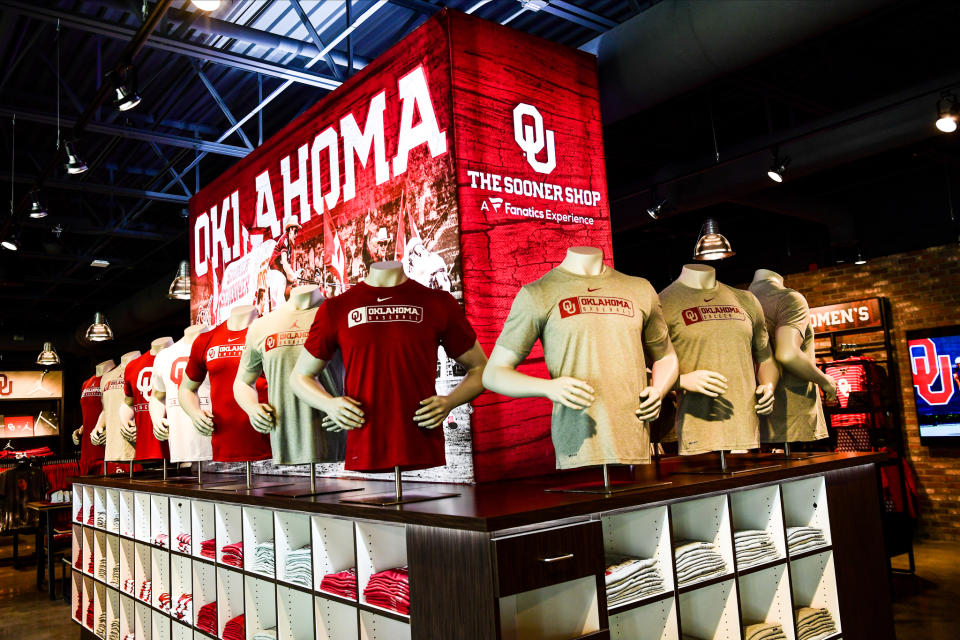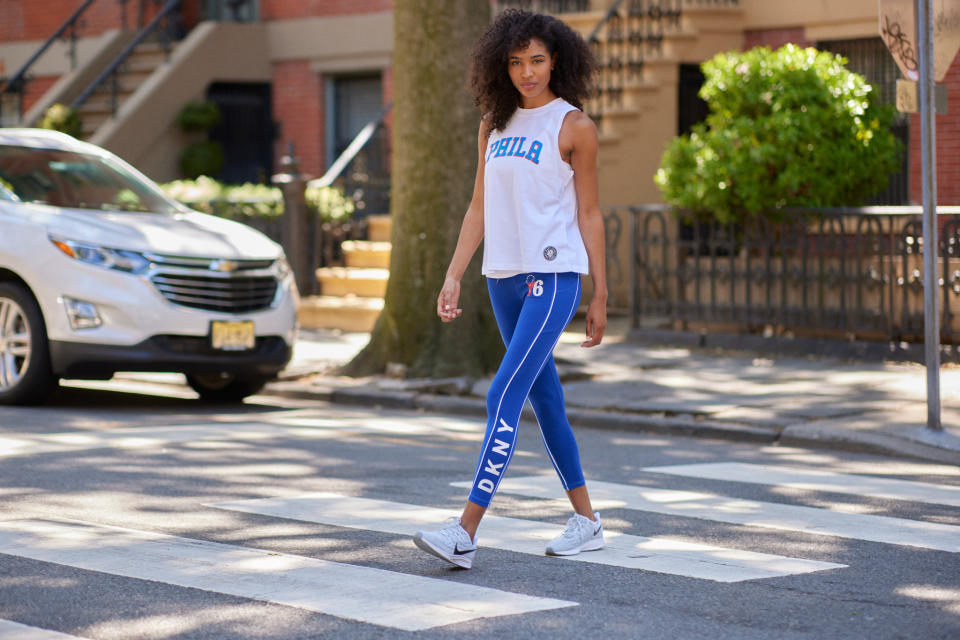CEO Talks: Doug Mack on Fanatics’ Fast Rise

Success in sports often boils down to that split-second reaction on the field and the training it took to be ready for it.
Turns out, the same is true in the sports business.
More from WWD
Witness Fanatics, where chief executive officer Doug Mack has built an agile giant, ready to spring into action when an athlete makes the play and pitch the right jersey to the right fans right away. Fanatics got its start within entrepreneur Michael Rubin’s Global Sports Inc., an apparel and logistics company he created in 1998. That morphed into the GSI Commerce e-commerce company that caught the eye of eBay, which purchased it for $2.4 billion in 2011. But because eBay only wanted the fulfillment part of GSI, Rubin was able to repurchase the sports e-commerce business which included Fanatics, a business that operated online stores for all the North American sports leagues and hundreds of teams and colleges.
It’s a trick that requires not just a complex bit of data-driven e-commerce, quick-turn production capacity and logistics savvy, but partnerships with 300 leagues and teams.
Together that counts as both good defense and good offense — something investors have recognized, tagging Fanatics with an eye-popping valuation of nearly $13 billion as whispers of a potential initial public offering grow louder.
In the middle of it all is Mack, a calm force and a Silicon Valley veteran who previously led One Kings Lane and became CEO of Fanatics in 2014.
He described the niche, North American e-commerce company he joined as “effectively the Zappos of licensed sports merchandise.” Now it is a multibillion-dollar global consumer player with more than 7,500 employees and something of its own to offer — merchandise that can’t be found anywhere else.
Mack has a direct line to the players and teams on one side and the ear of consumers on the other.
Here, he talks to WWD about how he makes the most of being in the middle and where Fanatics goes from here.
WWD: You just raised another $320 million and now have a valuation of $12.8 billion. How did you nearly double your valuation in a pandemic year and when sports were on pause for months?
Doug Mack: The pandemic really created a pretty massive shift to the online world, whether it’s work, education, entertainment, content, gaming, commerce — and we were in the middle of that. On one hand, we were fortunate as a digital-first company since with stores shut down, consumers had to shop online. The downside for us is that sports came off the field for nearly five months, which is our entire reason for being: we exclusively sell product for the sports fan. We had these countervailing forces on our business that we had to navigate last year. We’re largely an online operation, but we also operate 50 sports venues for teams, we sell some of our unique Fanatics merchandise in the traditional retail channel.
What really helped us succeed during the pandemic and drive up the valuation of the company is that we built a platform we call V-commerce, which means we marry product that we create and manufacture ourselves for various leagues and teams with being world-class in e-commerce. Why that’s so important in the sports space is the unpredictability of sports. Every day something interesting can happen: unexpected wins, losses, trades, drafts that through this direct-to-consumer reach with e-commerce allows us to immediately be in touch with your customer, which in our case is the fan, and you also have the ability to produce merchandise that meets their need at the moment.
WWD: How did you capitalize on the changing landscape of the pandemic?
D.M.: Our team very quickly activated what we call “The Peak Playbook.” The peak season for us is around holiday, it’s so large because every major sport is playing along with holiday buying trends. We have a NASA-like war-room approach to constantly read and react to what’s happening in peak, what our sales trends are, what categories are hot, what teams are hot, what marketing vehicles are working, is the site performing well. We applied that to the downtime, the four-and-a-half months without sports last year and our team found some really interesting things. Everybody went home for work and school, and casual apparel became a really important thing, so we really pushed that. Part of our business is hard goods and we have family sports-themed games and we really pushed that, too. We had some fun with it: we said, “Having a bad hair day, get a great new baseball cap.” I think that agility and that playbook that is usually applied to sports was applied to something that had never happened before. Sports fans are also loyal, so even though they weren’t playing, they still loved their teams so we marketed aggressively to keep fans engaged. That was one part of the story.
WWD: What was the rest of the pandemic playbook?
D.M.: The other part is we decided to be one of the most important companies in the world to help in the pandemic. There was a serious issue with protective equipment in the Northeast, most profoundly in the early days of the pandemic. We converted one of our domestic manufacturing facilities that traditionally produced baseball uniforms into a mask and gown production facility and donated more than 1 million masks to hospital workers throughout the Northeast. We also used our relationships with athletes and leagues and team owners to launch the All In Challenge. Beyond death and illness, we knew there was an issue with individuals who couldn’t get access to food and couldn’t feed their families due to job loss. So we raised $60 million through an online sweepstakes and set of auctions around great experiences to help those in need. The combination of how we got our business around the pandemic and how we also helped impact society caught the attention of investors. We stayed on offense, we raised our series E round last year during the pandemic, which doubled our valuation and people saw the fullness of the arc of our performance and then made a couple of acquisitions: Top of the World in the headwear space and Wincraft in the hard goods space. I think the bottom line is that we’re emerging stronger as a company with agile execution and well capitalized for the next phase.
WWD: You mention the All in Challenge and Michael Rubin was a big part of that. How involved is he in the day-to-day operation of Fanatics?
D.M.: Michael is our executive chairman and he really leads the vision and strategy for the company. When we think about where we’re going next and some of the big impactful things we want to take on, so much of that comes from his creative mind. And so much of what we do is rights-driven, so if we need to work with the leagues or a team and an athlete to sign a deal, he really drives the dealmaking and brings rights into the company for us to execute. I’m the CEO of the company and act as a traditional CEO with all the functions — during our peak season, we have around 10,000 global employees, more than $3 billion in revenue. One part of Michael’s involvement is these big ideas and strategy in dealmaking and the All In Challenge and the mask-making is when he woke up and said, “Hey, we really need to do something.” [Also] I’m very outspoken on the importance of diversity and inclusion in successful companies and that’s one of my personal crusades: to make Fanatics a stronger and better company internally. Michael’s crusade is to drive state-by-state reform on a grassroots level to get legislation passed. Overall, with everything he has going, the one area where he spends more of his time is Fanatics. He’s very active.

Courtesy Photo
WWD: You said you’re coming out of the pandemic stronger, but can you walk us through Fanatics 101 and tell us what’s the strongest part of the business today?
D.M.: When I joined Fanatics in 2014, we were effectively the Zappos of licensed sports merchandise. You could come to the Fanatics site, North America only, and we were only selling other people’s product: you could find third-party brands of various partners. It was the traditional e-commerce model. It was a nice business, but not a transformative business and not a particularly defensible business. When you’re in a world with the Amazons domestically and the Alibabas globally, their core models really commoditize products and boil things down to price and delivery, not merchandise. And so if you don’t have differentiated merchandise, you’re in big trouble against folks like that. So over the last seven years, we’ve really gone through a strategic expansion. The first is adopting this V-commerce, vertical commerce, model, where we create our own products and merchandise. And the whole goal there is that we will have differentiated merchandise on our site that you can’t find other places and have the agility that when something big happens in sports, you can service that fan demand. We went from 0 percent verticality when I joined to 50 percent this year, which is a very rapid ascent.
WWD: What else did you do?
D.M.: The other big thing is that we globalized. Sports leagues or teams have a global fan base and we partner with them to create a global footprint. And the third thing — I’m based in Silicon Valley — and we ramped up to become elite at data science. As the consumer comes on and wants to interact with Fanatics or one of our partners, whether it’s the NFL Shop or the NBA Store or the San Francisco 49ers where we power commerce on these partner sites, we wanted to provide the best, fastest, most relevant, richest experience to that fan. We’ve spent more than $150 million annually in the recent past on technology and data to be really strong on this front. The two big outputs from those inputs is that we’ve totally reinvented the fan experience. We have the right product and a broader range than anyone else, we’re more in stock, better at predicting trends and responding to trends and we have the right timing. We know in a moment when something exciting is happening with your team. And we’re also the ultimate partner for leagues and teams that want merchandise to be a tier one part of their business model. That’s really the Fanatics 101: we went from an $800 million domestic commerce company selling other people’s products to a multibillion-dollar, global, vertical brand that’s really powered by elite technology and data. We help the fans feed their passion and we help the league make merchandising a tier one part of their business model.
WWD: What elements of that do you think have really captured the attention of these investors who are buying in and led to bigger valuations?
D.M.: The notion that we have clear market leadership in licensed sports merchandising is one. There are lots of ways to win in the market and applying a traditional retail model to this industry is very hard because things change so fast. For example, a lot of people may think the New York Giants will be a really good team this year. Traditional retail says let’s go pre-book that nine months in advance, bring it in and put in the warehouses. And then let’s say the Giants get off to an 0-6 start, the demand is not going to be there. But say the New York Jets actually got off to a great start, you wouldn’t have product to service that fan base. That’s what’s so powerful about our model: we’ve architected it to be extremely agile from data and merchandising, so no matter who wins or loses, no matter who gets traded, we can service that demand, which not only is good for the fan, but it’s also great for growth. The third part that’s excited investors is the opportunity to continue to expand our business. Last January we announced Fanatics China, which is one of the next important geographies for licensed sports to connect leagues and teams in China. We did it with a very innovative joint venture with a partner there named Hillhouse. And then, even more recently, we announced our new venture called Candy Digital. NFTs are digital collectibles. We have a very large sports memorabilia business, which are signed items or game-use items from athletes, and there is going to be a platform shift where more and more digital items will become collectibles for the next generation of sportsmen.

Courtesy Photo
WWD: Can you describe what happens when there’s an amazing grand slam or unexpected win? How do you spring into action?
D.M.: Let me bring this to light through something that happened recently. I don’t know if you’ve been following Carl Nassib on the Las Vegas Raiders. But he’s the first NFL player who came out as being openly gay. And he announced this on social media with an incredible surge of support from the league and the community. That’s the perfect moment for our V-commerce model, because there are going to be fans of Carl Nassib who aren’t just Raiders fans, but they’ll want to represent him and what he supports. We have the rights to produce the Nike NFL jersey that would bear his name, we have blanks of those jerseys domestically. And then we have the ability to then finish them domestically. In the day before his announcement, I can tell you, we weren’t selling very many Carl Nassib jerseys, but once he made that announcement that created an immediate opportunity. So we begin to read the signals. That can trigger CRM campaigns where we can begin to reach out to individuals who we think are Raiders fans, we can go into social media, like Facebook, and do targeted advertising toward potential consumers who may be interested in his product. And then on the site, we can begin to feature it to make it easy to rank him highly in search results. Then there’s the behind the scenes for the supply chain. That week, he was our number-one-selling player in the NFL, higher than [Tom] Brady, higher than [Patrick] Mahomes. That’s just a perfect example of how this business is so unpredictable, you have to be able to react in real time. And we did.
WWD: You have a domestic manufacturing facility to do things like this?
D.M.: Yes, we have multiple facilities: we have the ability to cut and sew products in eastern Pennsylvania. We have jersey finishing, we have domestic screen printing. We also have a sports memorabilia facility so if somebody wants a Joe Montana jersey in a very specific way, we can actually do the creation and the framing.
WWD: You said 50 percent of your product now is your own. So what is your relationship with the big brands like Nike?
D.M.: There are basically three sets of relationships. With brands like Nike, New Era and Mitchell & Ness, they have interesting, unique product that they’ve licensed from leagues or teams to create themselves, we buy that product from them, and we sell it across the Fanatics network: Fanatics.com, the NFL shop, the NBA store, and hundreds of team and league sites globally. We are typically the number-one partner for anybody who’s a licensee who wants to sell licensed sports merchandise to consumers. Then we have our own licenses where we can produce a product that we’ve designed under the Fanatics brand. With some of our licensee partnerships, like Nike, we actually execute the product on behalf of Nike. We work with them to develop Nike branded product for the leagues, we do the sourcing, manufacturing and distribution of those products.
WWD: You have relationships with big retailers like Walmart and Amazon. So how does that fit into the mix?
D.M.: Walmart is one of our most important strategic partners in that they have thousands of physical stores all over the world, so when we have the rights to manufacture our own Fanatics vertical product, we sell to them on a wholesale basis. Then, we’re also Walmart’s exclusive partner in their online marketplace for licensed sports merchandise. And we have others: Kohl’s is an incredibly important partner where we distribute with them. We also operate their online presence. And Amazon is an emerging partnership. We’re piloting a program to dramatically improve the fan experience on Amazon for NFL merchandise and that’s just kicking off for this upcoming season.

Courtesy Photo
WWD: You’re primarily a digital company, but you operate some freestanding stores and retail venues at arenas. So how does that work?
D.M.: We operate approximately 50 venue retail stores ranging from the New Orleans Saints to the San Francisco Giants in baseball. And we also operate their e-commerce presence. It’s really all about creating one face today, if you are the Saints, and you have a fan coming to the New Orleans Saints digital experience, or the physical store, you want those to be a seamless experience. We also operate showcase retail stores in Manhattan with the NBA and NHL that are really brand stores to support the leagues and teams. But those are relatively small portions of the business.
WWD: How have things changed since sports have come back?
D.M.: One of the big adversity points of the pandemic was that we shut all of our sports venues down, but we didn’t sit on our hands. We did two things: one was to create a strategic plan for when venues open back up, how do we operate them safely for employees and fans? Number two is we have a lot of inventory in these venues and we went through a process to transfer the venue inventory into our e-commerce business, which performed quite well — and has continued to perform quite well. So you take venue inventory, which can get old, move it into e-commerce, e-commerce sells through while business is robust in the digital space, and when we come back this year and stadiums welcome fans back in, we have brand new, fresh inventory in the venues. If somebody’s not working with Fanatics because they’re self-operating their own venues or they’re working with a food and beverage service provider who’s great at food but not so good at merchandise, they basically have last year’s product clogging up the store. Fans are coming back excited to be at the games and seeing old product and nobody wants a throwback to 2020 right now — we’re all ready to move on.
WWD: Where does women’s fit into the picture?
D.M.: We’ve been working for multiple years on a strategy to disrupt the women’s category in licensed sports merchandise. I think historically the industry has shown a very narrow range of products that appeal to a narrow range of consumers. And so we’ve been driving a better brands strategy to bring her more choice and appeal to a broader audience of women. We have an incredible partnership with Erin Andrews, who’s a great sports broadcaster and personality with a phenomenal following and she’s collaborated with us to develop NFL product that is exceptional and high end. We also partner with Vineyard Vines, DKNY Sport, Tommy Hilfiger. We believe the women’s category is one that has been underserved historically that we’re really pushing into.
WWD: What do you view as other growth areas?
D.M.: We believe the college market is very exciting. When people think of sports, they often go right to professional sports and go right to jerseys. Those are big parts of the market. But when you think about colleges, you don’t even have to be a hardcore sports fan to be a fan of your school. So we’re creating these primary apparel partnerships with many colleges and using our V-commerce model to bring dramatically better merchandise.
WWD: What about categories such as gaming or even ticket sales?
D.M.: We have a database of more than 80 million fans, which is probably the most valuable database in sports. But when we think about the broader sports ecosystem, we need somebody to come in and help us think that through. And that’s really where we’re at now.

Courtesy Photo
WWD: An IPO has been mentioned several times for you. What would you gain or lose by becoming a public company?
D.M.: It cuts both ways. We are well capitalized as a business as you know, from our last two private fundraisers. So we don’t need an IPO to raise capital because we’re well capitalized and we’re cash-flow positive. The primary things to gain via an IPO would be to raise our visibility even further with the tens, or hundreds of millions of consumers. And we’ve been fairly acquisitive as a company and that’s a little bit harder as a private company. The case against that is that as part of our culture, we’re extremely transparent internally, continually sharing the scorecard of how we’re performing, what we’re doing well and what we need to work on. And once a company becomes public, you lose the ability to share as much information internally.
WWD: Who do you view are your primary competitors?
D.M.: One of the worst in this industry are counterfeiters who don’t have legal licenses and go off and create product and put it in the marketplace, it’s called ambush product. That’s the scourge of the industry. They have a different cost structure, they’re not actually paying the fees to leagues and teams. That’s a huge problem. But if we focus on great fan experiences, and making leagues and teams successful with our model, we’ll look to our partners at the leagues and teams to enforce their intellectual property to ensure that we don’t have to face competitors who are on an unequal playing field.
Sign up for WWD's Newsletter. For the latest news, follow us on Twitter, Facebook, and Instagram.

